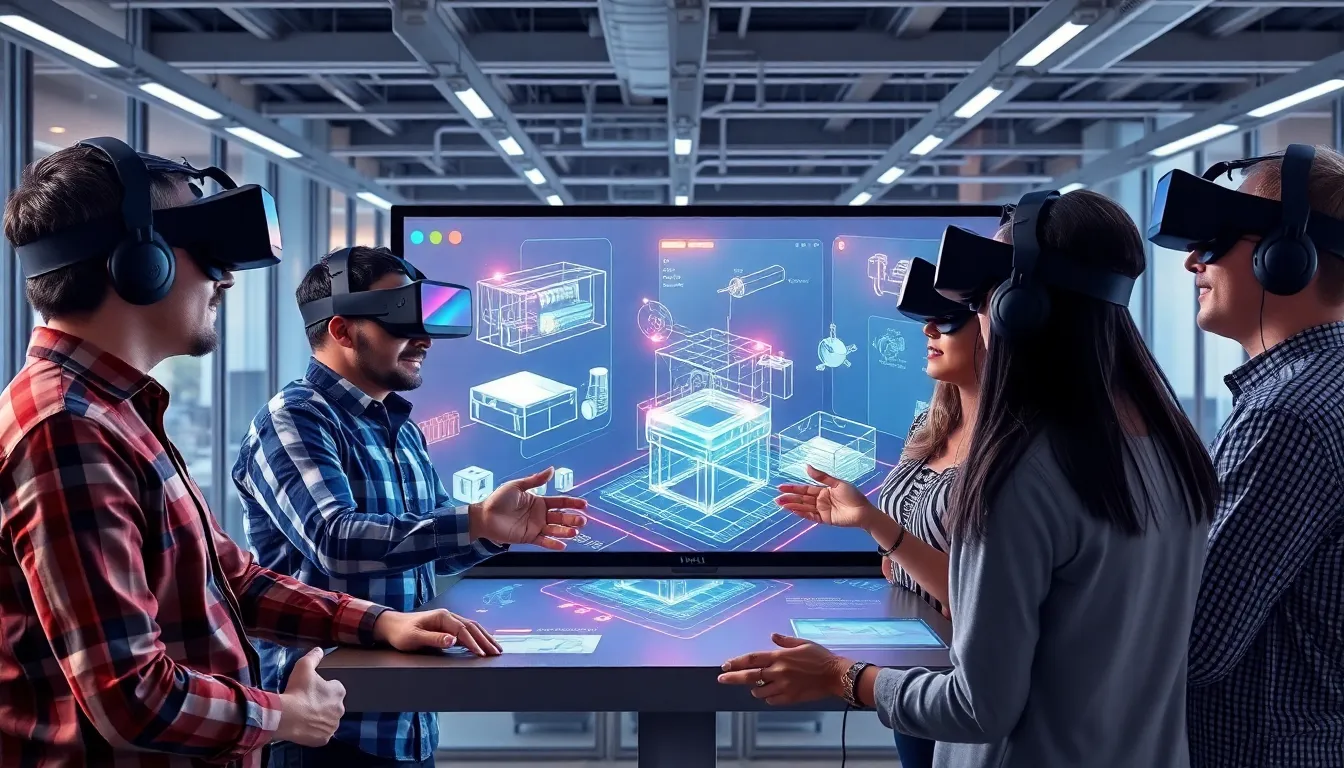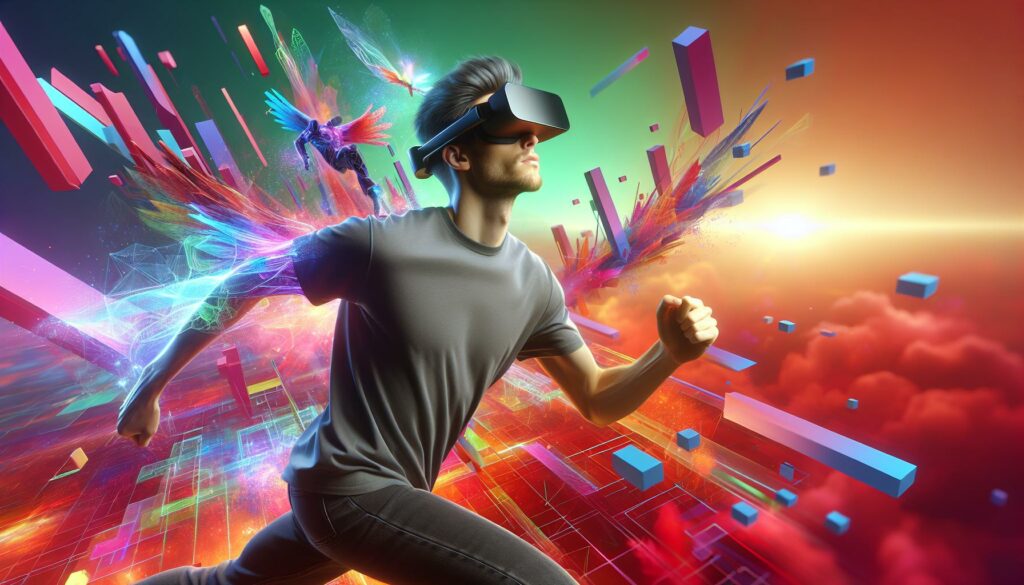In a world where reality sometimes feels a bit too mundane, augmented and virtual reality companies are stepping in like superheroes in spandex. They’re transforming how we interact with technology and each other, making the impossible seem possible. From gaming to education, these innovators are crafting experiences that blur the lines between the digital and the real, and let’s be honest, who wouldn’t want to battle dragons while sipping coffee on their couch?
As AR and VR technology continues to evolve, a new wave of companies is emerging, each with its own unique flair and vision. Whether it’s creating immersive training simulations or bringing art to life, these pioneers are not just pushing boundaries; they’re redefining them. So buckle up, because diving into the world of AR and VR companies is like stepping into a thrilling adventure—one where the only limit is imagination.
ar vr companies
AR and VR companies are at the forefront of transforming how people perceive and interact with their environments. Industry leaders such as Oculus, Magic Leap, and Niantic are pioneering advancements in immersive technology. Notably, Oculus focuses on delivering high-quality VR experiences for gaming and social interaction. Magic Leap emphasizes enterprise applications, enabling businesses to harness AR for productive workflows.
Innovative startups also contribute to the ecosystem. Companies like Varjo and HoloLens develop cutting-edge hardware that enhances visual fidelity. Varjo’s unique approach to mixed reality elevates simulation training across various sectors. HoloLens integrates AR capabilities into everyday business practices, improving collaboration and productivity.
Market trends indicate significant growth potential. The global augmented and virtual reality market is projected to reach $100 billion by 2026. Adoption rates are climbing, with educational institutions utilizing AR experiences to enhance learning. Brands leverage AR for interactive advertising campaigns, connecting with consumers in novel ways.
Various sectors have begun realizing the benefits of AR and VR. Healthcare organizations use these technologies for surgical training, allowing practitioners to practice in lifelike scenarios. Retailers employ AR to enhance the shopping experience, enabling customers to visualize products before purchase. Entertainment companies integrate VR into theme parks, offering visitors unforgettable experiences.
Collaboration among tech entities is reshaping development strategies. Partnerships between hardware and software companies lead to groundbreaking projects that broaden the scope of AR and VR applications. This convergence of expertise fuels innovation, creating immersive solutions that push boundaries and captivate audiences.
Key Players in the AR VR Industry

The AR and VR industry features several companies that significantly influence technology. They create enriched, immersive environments across various sectors.
Leading AR Companies
Magic Leap stands out for its innovative mixed reality applications, particularly in enterprise solutions. Niantic revolutionized location-based experiences with Pokémon GO, showcasing the potential of AR in gaming. Snap Inc., through its Snapchat platform, pushes boundaries by integrating AR features that enhance social interactions. Companies like Blippar focus on AR marketing, providing brands with unique customer engagement strategies. Additionally, PTC has developed solutions that cater to industries such as manufacturing and healthcare.
Leading VR Companies
Oculus, a subsidiary of Meta Platforms, leads in consumer VR, focusing on gaming and social experiences. Valve has garnered attention for its innovative VR hardware and titles, enhancing user immersion with the Valve Index. HTC Vive excels in premium VR experiences, catering to both consumers and businesses alike. Sony’s PlayStation VR continues to attract gamers with exclusive titles and immersive gameplay. Startups like Varjo push the envelope with high-fidelity VR headsets designed for professional use, targeting sectors such as training and design.
Innovations and Trends
AR and VR companies continue to reshape how users engage with technology, driving new breakthroughs in the industry. Many of these advancements reveal significant opportunities for business and entertainment sectors.
Emerging Technologies
Innovators in AR and VR are focusing on advancements such as eye-tracking and haptic feedback. Eye-tracking technology enables more natural interaction, enhancing user experiences in gaming and training. Haptic feedback provides tactile sensations, simulating real-world interactions. Companies are also exploring cloud-based solutions, allowing for data-heavy applications without requiring high-end hardware on the user’s end. Mixed reality systems that blend real and digital environments gain traction, providing immersive experiences beyond traditional applications. As AI integration becomes more prevalent, personalized content creation and smarter interactivity emerge.
Market Trends
Market dynamics show AR and VR technologies growing rapidly, with projections indicating a $100 billion growth by 2026. Enterprise applications dominate, as companies like Magic Leap revolutionize productivity via immersive training tools. Location-based AR experiences, particularly from Niantic, enhance real-world engagement, capitalizing on user mobility. Consumer interest in gaming remains strong, bolstered by Oculus and its competitors. Retail sectors increasingly adopt AR for virtual try-ons and interactive advertising, enhancing customer experiences. Startups continue to disrupt, introducing innovative solutions that meet evolving consumer demands, significantly impacting market shifts.
Challenges Faced by AR VR Companies
AR and VR companies encounter numerous hurdles that can hinder their growth and innovation. Addressing these challenges is crucial for their success and relevance in a burgeoning market.
Technical Challenges
Developers face various technical challenges when creating AR and VR experiences. Limited hardware capabilities often restrict the level of immersion achievable, impacting user experience. Additionally, software integration issues can arise, complicating the development of seamless applications. Content creation represents another significant hurdle, as generating high-quality, engaging experiences demands substantial resources and expertise. Companies must also tackle concerns related to user comfort, including motion sickness, which affects widespread adoption. Connectivity issues in online experiences further complicate the landscape, often detracting from the overall quality and accessibility of products.
Market Adoption Issues
Market adoption presents a notable challenge for AR and VR companies. High costs associated with advanced technology can deter potential users, especially in consumer sectors. Familiarity plays a role; many individuals remain unaware of the benefits and functionalities these technologies offer, leading to skepticism. Companies also compete against established technologies, making it difficult to persuade users to embrace new solutions. Resistance from traditional industries can hinder integration, limiting AR and VR applications in sectors like healthcare and education. These barriers necessitate effective marketing strategies to demonstrate value and drive user interest and engagement.
Future Outlook for AR VR Companies
Rapid advancements in AR and VR technologies signal a promising future for these companies. Market research firm estimates project that the AR and VR market will reach $100 billion by 2026. Such growth is driven by a variety of sectors utilizing these innovations, particularly healthcare and retail, where immersive experiences enhance user engagement.
Innovative startups and established leaders contribute significantly to this trajectory. Oculus aims for continued leadership in consumer VR, while companies like Magic Leap and Niantic expand enterprise applications. Strategic partnerships between tech entities further accelerate development strategies. Collaborations result in groundbreaking projects that redefine immersive experiences.
Innovations in eye-tracking, haptic feedback, and cloud-based solutions play crucial roles. Enhanced user experiences in gaming and training accompany these technologies. High-quality content creation remains essential for success, as it directly affects user satisfaction.
Challenges persist despite promising growth. Technical limitations, such as hardware capabilities and software integration issues, can impede progress. User comfort remains a critical concern, particularly with motion sickness and connectivity hurdles. Additionally, market adoption poses significant barriers, as high costs and unfamiliarity deter potential users.
Companies face competition from established technologies, making it essential to demonstrate the value of AR and VR solutions. Resistance from traditional industries adds another layer of complexity. Nevertheless, the potential for transformation remains vast. As companies innovate and adapt, AR and VR could fundamentally change how individuals interact with technology in everyday life.
Conclusion
The future of AR and VR companies is bright and filled with potential. As technology continues to evolve these companies will play a crucial role in shaping how people interact with digital content. With ongoing innovations and strategic collaborations the industry is poised for significant growth.
Challenges remain but the drive for immersive experiences will push these companies to overcome obstacles. As they refine their technologies and expand their applications the impact of AR and VR will be felt across various sectors. This dynamic landscape invites exploration and engagement from both consumers and businesses alike. The journey into AR and VR is just beginning and the possibilities are truly limitless.


![[author] arkit and unity: build a drivable car in augmented reality course](https://wzhi58.com/wp-content/uploads/2024/11/1b145239-102d-43d9-8674-80113a75e375_hGjkhjyx0SxSyWk99mwY3-1024x585.jpeg)
